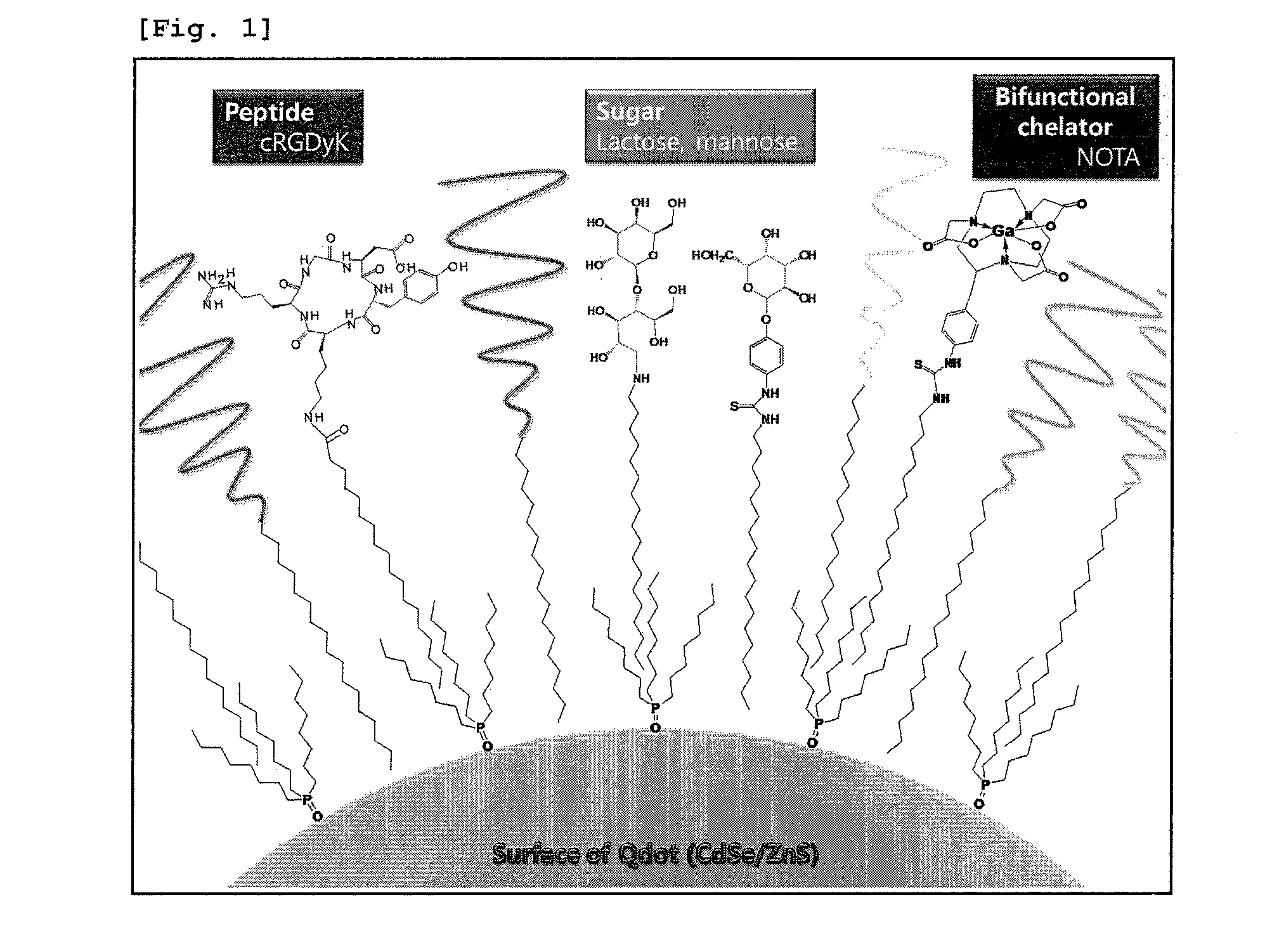Nanoparticle coated with ligand introduced with long hydrophobic chain and method for preparing same
a technology of hydrophobic chain and nanoparticle, which is applied in the directions of peptide/protein ingredients, granular delivery, powder delivery, etc., can solve the problems of inability to apply, deterioration of efficiency, and difficulty in prediction of reaction reaction and reproducibility
- Summary
- Abstract
- Description
- Claims
- Application Information
AI Technical Summary
Benefits of technology
Problems solved by technology
Method used
Image
Examples
example 1
Synthesis of RGD-Stearate
[0073]c(RGDyK) (0.010 g, 0.02 mmol) was dissolved in chloroform (0.5 ml) and triethylamine (TEA; 0.007 ml, 0.05 mmol) was added. After stirring at room temperature for one night, stearoyl chloride (0.015 g, 0.05 mmol) was added, followed by stirring at room temperature for one more night for reaction. The reaction was confirmed to be concluded through mass spectrometry, when the c(RGDyK) peak disappeared and the RGD-stearate peak appeared. The reaction mixture was washed with water, and the organic layer was separated and concentrated. Then, the resulting compound was dissolved again in acetonitrile (1 ml) and recrystallized which gave 8 g of end product. Yield: 57%. Mass spectrum (ESI+), (M+H+): 886.6.
example 2
Synthesis of NOTA-SCN-Stearylamine
[0074]2-(p-isothiocyanatobenzyl)-1,4,7-triazacyclononane-1,4,7-triacetic acid (NOTA-SCN, 0.020 g, 0.04 mmol) was dissolved in chloroform (1 ml) and TEA (0.012 ml, 0.09 mmol) was added, followed by stirring at room temperature. Stearylamine (0.014 g, 0.05 mmol) was added to the reaction mixture and stirred at room temperature for 20 hours. The reaction was confirmed to be concluded through mass spectrometry, when the NOTA-SCN peak disappeared and the NOTA-SCN-stearylamine peak appeared. Then, the resulting compound was recrystallized two times in ether (3 ml×2) which gave 26 mg of end product. Yield: 72%. Mass spectrum (ESI+), (M+H+): 720.5.
example 3
Synthesis of DOTA-SCN-Stearylamine
[0075]2-(p-isothiocyanatobenzyl)-1,4,7,10-tetraazacyclotetradecane-1,4,7,10-tetraacetic acid (DOTA-SCN, 0.020 g, 0.04 mmol) was dissolved in chloroform (1 ml) and TEA (0.015 ml, 0.10 mmol) was added, followed by stirring at room temperature. Stearylamine (0.015 g, 0.06 mmol) was added to the reaction mixture and stirred for one night. The reaction was confirmed to be concluded through mass spectrometry, when the SCN-DOTA peak disappeared and the SCN-DOTA-stearylamine peak appeared. Then, the resulting compound was recrystallized two times in ether (3 ml×2) which gave 23 mg of end product. Yield: 77%. Mass spectrum (ESI+), (M+H+): 821.5.
PUM
| Property | Measurement | Unit |
|---|---|---|
| size | aaaaa | aaaaa |
| hydrophobic | aaaaa | aaaaa |
| MRI | aaaaa | aaaaa |
Abstract
Description
Claims
Application Information
 Login to View More
Login to View More - R&D
- Intellectual Property
- Life Sciences
- Materials
- Tech Scout
- Unparalleled Data Quality
- Higher Quality Content
- 60% Fewer Hallucinations
Browse by: Latest US Patents, China's latest patents, Technical Efficacy Thesaurus, Application Domain, Technology Topic, Popular Technical Reports.
© 2025 PatSnap. All rights reserved.Legal|Privacy policy|Modern Slavery Act Transparency Statement|Sitemap|About US| Contact US: help@patsnap.com



